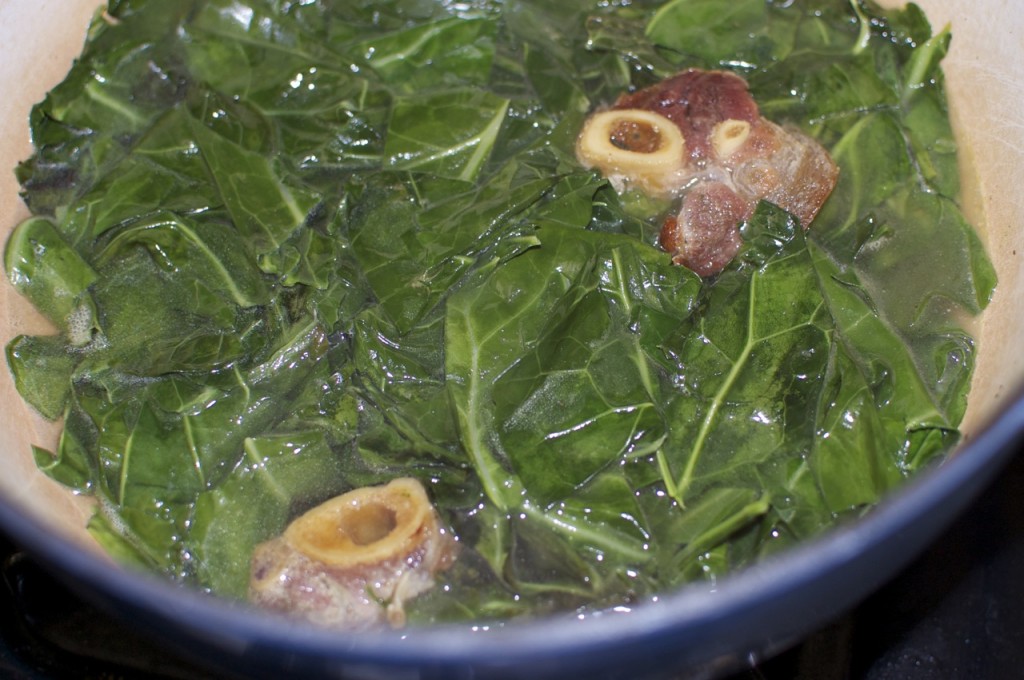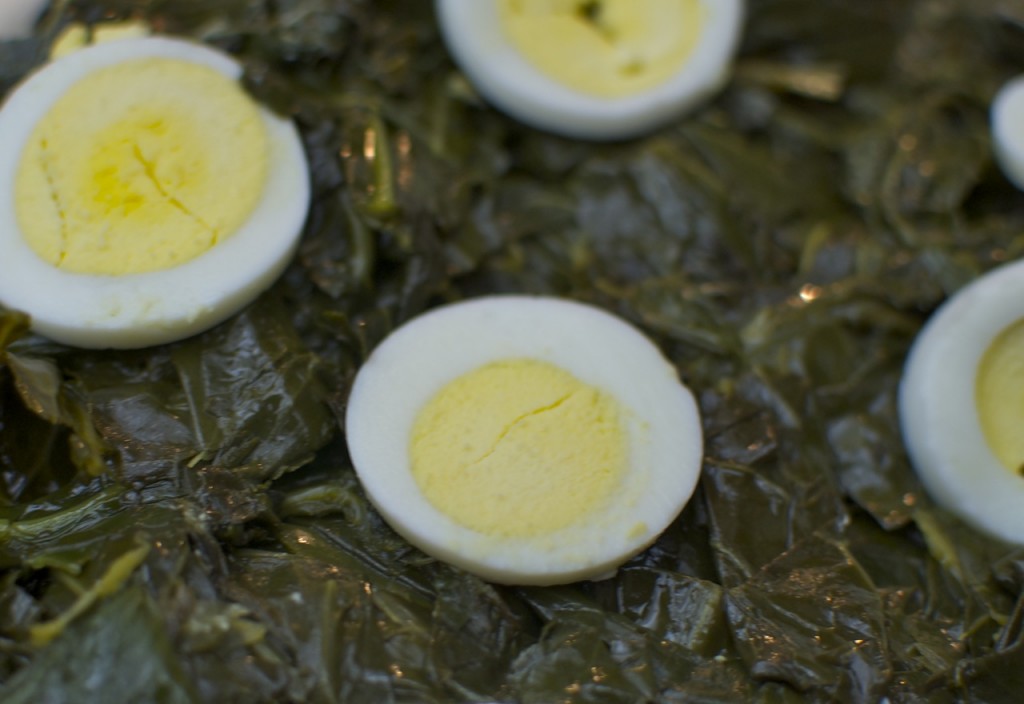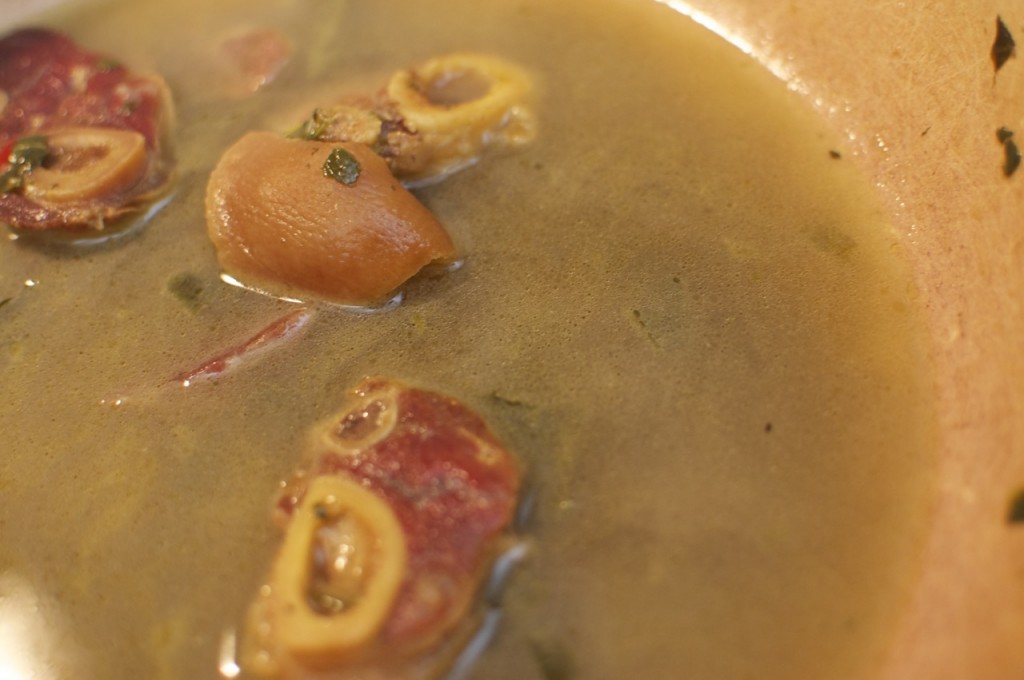Collard greens are one of those foods I learned to appreciate only after I got grown. I’m not sure why I didn’t like them as a child, although I suspect it had something to do with their odor, which I still don’t care for. In fact, I think I’ll start setting up the camp stove in the backyard whenever I decide to cook up a mess of collards so it doesn’t stenchify the house. (Funny thing about Southern expressions–they only work with our indigenous foods. Have you ever heard a Southerner talk about whippin’ up a mess of escargot or sushi?)
As with so many Southern dishes, this one is cooked more by instinct and personal taste than with a recipe. I use two bunches of collard greens to make about four servings. Greens are deceptive–you think you have way too many when you start out, but they always cook down to nearly nothing. So put on your biggest pot and throw in as many greens as you can.
As with any type of green, rinse them well, so you don’t get those dastardly gritty bits caught in your teeth. I start with a generous dollop of bacon drippings melted over medium high heat, to wilt the greens before adding about three cups of water, a little salt and some red pepper flakes and tossing in some hog jowl, hamhocks, ham bits, bacon or whatever pork you have lying around. The pork additions are salty, so add salt judiciously. Simmer for about 40 minutes, or longer if necessary, until the chewiness is gone. While spinach cooks up quickly, collards are thicker and more leathery, and they take considerably longer to cook. Sprinkle on some pepper vinegar if they seem a little gamey and set the bottle on the table so everyone can fine tune their own serving.
I put on some eggs to hard boil while the collards simmer. One of the classic Southern presentations (now there’s a prissy expression you don’t often hear at the Southern table!) is to serve them topped with slices of hard boiled egg. If your only source of protein for the meal is just a few bits of ham or bacon in the greens, it’s good to get a little extra from the eggs. And it looks pretty, don’t you think?
What’s left behind after you get all the greens out of the pot is healthier than the greens themselves. This is the pot likker, and it’s where all the Vitamin A go during cooking. Well, I say it’s healthier, but there’s a fair amount of pork fat in there. That’s okay if you’re about to go plow the back forty. Some people like the pot likker best of all, spooned over cornbread or biscuits. Never throw this stuff away! You can at least keep it and use it as a soup base.
I’ve had really good collards in Ethiopian restaurants, where they’re steamed and served sprinkled with olive oil, garlic and spices, but for me, preparing them in a pork fat spa is still the way to go. As they say, you can take the girl out of the country, but you can’t take the country out of the girl.



















Wonderful Recipe!!! My mouth watered the entire time I read this, and the childhood memories flooded back. I loved turnip/collard greens so much that I would eat the leftovers cold with vinegar– in the days before microwaves. Do I remember that they were sometimes cooked in a pressure cooker…or was it an iron skillet? No, I think jut a big pot with the lid on it. If the ham was ‘country ham’ so much the tastier. Thanks Carol, now I am sooo hungry.
Hey Cousin,
I remember greens cooking in big pots and deep iron skillets. I suppose a pressure cooker could have been involved, but I bet you’d spend more time cleaning it than cooking greens in it. They’re low maintenance–leave ’em on the back burner and do something else while they cook. It seems like in some kitchens there was always a pot of greens on the stove, like they never got put away, if there were ever any left. They were simply a fixture of a lot of Southern kitchens.
As for ham, it HAD to be country ham, Deb. We’d never heard of any other kind. Honey-Baked? What planet did THAT come from?!